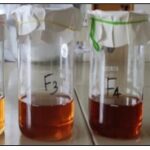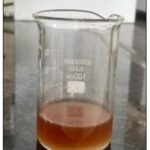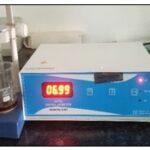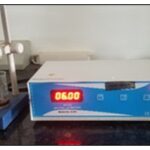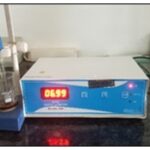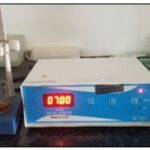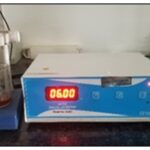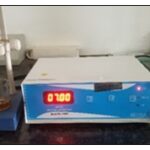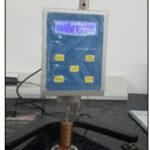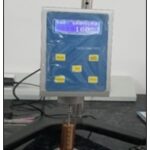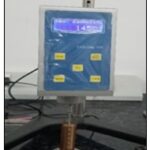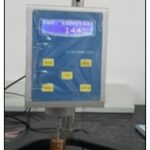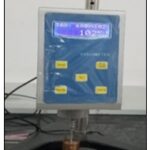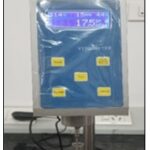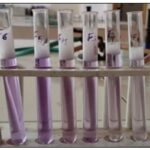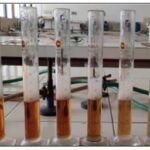FORMULATION & EVALUATION OF POLYHERBAL SHAMPOO
HTML Full TextFORMULATION & EVALUATION OF POLYHERBAL SHAMPOO
Navneet Jaiswal, Abhishek Kumar Singh, Khushi Kumari, Tanmay Jit *, Saumendu Deb Roy, Dibyendu Shil, Jashabir Chakraborty and Sanglap Mallick
Department of Pharmaceutics, Mata Gujri College of Pharmacy, Mata Gujri University Kishanganj, Bihar, India.
ABSTRACT: The aim of this study is to prepare and formulate an herbal shampoo and evaluate its physiochemical properties for safety and efficacy which contain safe natural ingredients. Shampoo is a hair care product used for the removals of dirt, oils, skin particles, environmental pollutants and other foreign particle which build up in hair. The shampoo is enriched with herbal extract without any synthetic additives. The herbal extract used in formulations are Punica grantum (pomegranate), Curcuma longa (turmeric), Sapindus mukorossi (ritha), Datura metal (datura), Pisidium guajira (guava), Azadinachta indica (neem), Hibiscus rosa-sinensis (shoe black plant), Citrus sinensis (orange), Zingiber officinale (ginger), Allium sativum (garlic), Allium cepa (onion), Cuminum cyminum (jeera). Herbal shampoo was prepared by simple mixing process. The herbal shampoo was tested for physicochemical properties. Some of methods are visual inspection, pH determination, solubility check, cleansing action, determination of percentage solid content, viscosity evaluation, dirt dispersion, foaming ability detergency ability and stability studies.
Keywords: Herbal shampoo, Detergents, viscosity, Stability studies, Solid content
INTRODUCTION: Since ancient times, humans have used herbs to clean and beautify their hair, which is an essential component of human beauty. Synthetic agents have accounted for a significant portion of the market over time, but consumers are becoming more conscious of their negative effects on eyes, skin, and hair 1. The population was drawn to herbal products since they were less expensive and had less adverse effects. The term herbal denotes an indication of safety as opposed to synthetic, which is harmful to human health. Shampoos are used for more than just cleansing hair; they also keep hair lustrous, thicker, longer-lasting, and free of oiliness.
Shampoo is a hair care product that is used to clean hair. It usually comes in the form of a thick liquid. Shampoo is a liquid or cream-based mixture of soap or detergent used to cleanse hair. The goal of using shampoo is to remove the unwanted particles and dirt which build up in the hair and which help to control scalp bacteria 2, 3. Shampoo is a hair care product that is used for the elimination of the oils, dusts, pore and skin debris, dandruff, environmental pollution and other contaminant particle that are regularly increases in the hair. Shampoo is typically composed of 10 to 20 ingredients. Shampoo comes in a variety of forms, including powder, transparent liquid, lotion, solid gel, medicinal, and liquid herbal 4, 5, 6.
Ideal Properties of Shampoo 7, 8:
- It should not cause irritation on scalp, eye and skin.
- Produce pleasant fragrances from hair.
- Produce good amount of foam.
- To make hair smooth and shiny.
- It should remove completely dirt and other foreign particle from hair.
- It should completely remove by rinsing water on hair.
Shampoo Must Contains 9, 10:
- Detergents
- Conditioners
- Thickeners
- Fragrances
- Preservatives
MATERIALS AND METHODS:
Collection of Plant Material: Fresh hibiscus flowers, datura leaves, guava leaves, and neem leaves were gathered from Kishanganj's neighbourhood gardens which located in Bihar. We gathered pomegranate, Retha, turmeric, orange, garlic, and onion from the Kishanganj local market.
Preparation of Crude Extracts: Weight all the ingredients like Punica grantum, Curcuma longa, Datura metal, Pisidium guajara, Azadinachta indica, Hibiscus rosa-sinensis, Citrus sinensis, Allium sativum, Allium cepa and Sapindus mukorossi which conditioning antimicrobial and antifungal properties and these are extracted using water as a solvent and other solvent.
(All the ingredients become puffy and filled with water or other solvent). After that boil some ingredients in the same water on medium flame then cool the extract and filtered and stored in cold temperature.
TABLE 1: INGREDIENTS USED IN THE FORMULATIONS OF POLYHERBAL SHAMPOO
| Name of plant | Scientific name | Use |
| Pomegranate | Punica grantum | Antimicrobial and antidandruff |
| Turmeric | Curcuma longa | Anti-inflammatory |
| Datura | Datura metal | Increase hair growth |
| Guava | Pisidium guajara | Antibacterial |
| Neem | Azadinachta indica | Antibacterial |
| Shoe black plant | Hibiscus rosa-sinensis | Conditioning agent |
| Orange | Citrus sinensis | Reduce hairfall or antidandruff |
| Garlic | Allium sativum | Anti-inflammatory or hair strengthening |
| Ritha | Sapindus mukorossi | Foaming agent or cleanser for hair |
Preparation of Polyherbal Shampoo: Table 2 displays the formula for the shampoo that was prepared by combining the plant extracts in various ratios. Herbal extract was combined in one part with an adequate amount of water, and then triethanolamine lauryl sulphate was combined with further water parts. Methyl paraben was then added and stirred. Finally, a sufficient amount of citric sinensis solution was added to the solution to adjust its ph. A few drops of rose essential oil were added to the prepared shampoo to give it some scent, and 50 mL of water solution was added to adjust its volume.
TABLE 2: FORMULATION DESIGN OF POLYHERBAL SHAMPOO
| Plant name | Part used | Quantity (50 ml) | |||||
| F1(ml) | F2(ml) | F3(ml) | F4(ml) | F5(ml) | F6(ml) | ||
| Pomegranate | Fruit | 0.25 | 0.5 | 1 | 1.5 | 2 | 2.5 |
| Ritha | Fruit | 3 | 3 | 3 | 3 | 3 | 3 |
| Turmeric | Root | 0.25 | 2.5 | 2.5 | 2.5 | 2.5 | 2.5 |
| Datura | Leaves | 0.25 | 2 | 2 | 2 | 2 | 2 |
| Guava | Leaves | 1 | 1.5 | 1.5 | 1.5 | 1.5 | 1.5 |
| Neem | Leaves | 0.25 | 0.5 | 1 | 1.5 | 2 | 2.5 |
| Shoe black plant | Flower | 1 | 1 | 1 | 1 | 1 | 1 |
| Orange | Peel | 1.5 | 1.5 | 1.5 | 1.5 | 1.5 | 1.5 |
| Garlic | Tuber part | 0.25 | 2.5 | 2.5 | 2.5 | 2.5 | 2.5 |
| Onion | Tuber part | 1 | 1.5 | 1.5 | 1.5 | 1.5 | 1.5 |
| Triethanolamine lauryl sulphate | - | 10ml | 10ml | 10ml | 10ml | 10ml | 10ml |
| Methyl paraben | - | 0.25 | 0.25 | 0.25 | 0.25 | 0.25 | 0.25 |
| Water | - | Q.S | - | - | - | - | - |
| Perfume | - | Q.S | - | - | - | - | - |
FIG. 1: POLYHERBAL SHAMPOO FORMULATION
Evaluation of Polyherbal Shampoo: To evaluate the prepared formulations, quality control tests, such as viscosity, density and pH measurements as well as visual inspection percentage of solid contents, dirt dispersion, cleaning action, detergency ability, foaming ability and stability testing were carried out to examine the prepared formulations. Additionally, particular tests for shampoo formulations, such as the measurement of dry residue and moisture content, total surfactant activity, salt content and surface tension are performed to ensure the quality of the products. Tests for detergency, mechanical, and thermal stability were conducted.
Physical Appearance/visual Inspection: The prepared formulations were assessed for clarity, fluidity, and capacity to produce foam.
Determination of pH: Use a pH meter set to 27°C to measure the pH after mixing 01g of shampoo with 09ml of water.
Determine Percent of Solids Contents: Taken an evaporating dish, it was dried and cleaned was weighed and 4 grams of shampoo was added. The dish and shampoo were weighed.
The shampoo's exact weight was determined after by placing the evaporating dish with shampoo on a hot plate and waiting for the liquid to evaporate. After drying, the weight of the shampoo alone (solids) was determined.
Viscosity Evaluations: A Brookfield viscometer was used to measure the shampoos' viscosity. After dipping a spindle for approximately five minutes in a beaker containing 10 mL of shampoo, readings are taken.
Cleaning Action: 5 grams of wool yarn were dipped in grease, and then the mixture was added to 200 ml of water in a flask with 1gm of shampoo. The water's temperature was kept at 350 degrees Celsius. For 4 minutes, the flask was shaken fifty times a minute. After that the solution was removed and sample was taken out then dried and weighed. DP is equal to 100(1-T/C). Where T is the weight of sebum in the test sample, C is the weight of sebum in the control sample, and DP is the percentage of detergency power.
Dirt Dispersion: 10 ml of distilled water were placed in a big test tube, and two drops of shampoo were added. After that adding one drop of India ink, the test tube was sealed and shaken ten times. An estimate of the amount of ink in the foam was None, Light, Moderate, or Heavy.
Foaming Ability and foam Ability: The cylinder shake method was employed to assess foaming capacity. A 250 ml graduated cylinder was filled with 50 ml of the 1% shampoo solution, and the cylinder was shaken ten times while being covered with a hand. The total volumes of the foam contents after 1-minute shaking were recorded.
The foam volume was calculated only. Immediately after shaking the volume of foam at 1-minute intervals for 4 minutes were recorded.
Detergency Ability: Detergency ability of herbal formulation was evaluated by the Thompson method. Briefly, a crumple of hair was washed with a 5% sodium lauryl sulphate (SLS) solution, then dried and divided into 3g weight groups. The samples were suspended in a hexane solution containing 10% artificial sebum and the mixture was shaken for 15 minutes at room temperature. Then samples were removed, the solvent was evaporated at room temperature and their sebum content determined. In the next step, each sample was divided into two equal parts, one washed with 0.1 ml of the 10% test shampoo and the other considered as the negative control. After drying, the resided sebum on samples was extracted with 20 ml n-hexane and re-weighed. Finally, the percentage of detergency power was calculated using the following equation:
DP=100(1 T/C)
In which, DP is the percentage of detergency power, C is the weight of sebum in the control sample and T is the weight of sebum in the test sample 3, 4.
Stability Testing: The formulations' thermal stability was investigated by putting them in glass tubes and keeping them in a humidity chamber at a temperature of 45°C and a relative humidity of 75%. At one-month intervals, their physical stability and appearance were examined for three months.
RESULT AND DISCUSSION:
Evaluation of Polyherbal Shampoo:
Physical Evaluation/visual Inspection: The formulations were visually inspected and the colour and odor of each formulation was noted and recorded. Table 3 contains the result of the physical appearance of a series of formulations.
FIG. 2: POLYHERBAL SHAMPOO
TABLE 3: EVALUATION OF FORMULATION FOR PHYSICAL APPEARANCE
| Sr. no. | Formulation | Physical appearance |
| 01 | F1 | Dark brown and orange like smell |
| 02 | F2 | Dark brown and orange like smell |
| 03 | F3 | Dark brown and orange like smell |
| 04 | F4 | Dark brown and orange like smell |
| 05 | F5 | Dark brown and orange like smell |
| 06 | F6 | Dark brown and orange like smell |
Determination of pH: It has been demonstrated that shampoo pH plays a significant role in maintaining the ecological balance of the scalp, reducing eye irritation, and boosting the appearance of hair. pH is one of the ways to reduce damage to hair. As can be observed from table no. 04, every shampoo had an acid balance between 6.0 to 7.0, which is close to the pH of skin.
TABLE 4: DETERMINATION OF pH
| Sr. no. | Formulation | pH |
| 01 | F1 | 6.99 |
| 02 | F2 | 6.00 |
| 03 | F3 | 6.99 |
| 04 | F4 | 7.00 |
| 05 | F5 | 6.00 |
| 06 | F6 | 7.00 |
FIG. 3: F1 FORMULATION
FIG. 4: F2 FORMULATION
FIG. 5: F3 FORMULATION
FIG. 6: F4 FORMULATION
FIG. 7: F5 FORMULATION
FIG. 8: F6 FORMULATION
Determination of Solid Contents: If the shampoo contents too many solid particles it will be very difficult to work into the hair or very difficult to wash it. The result of percentage of solids contents is represent in Table 5 and was found between 20 to 29%. As a result, they were simple to clean it.
TABLE 5: PERCENTAGE OF SOLID CONTENTS
| S. no. | Formulation | Solid contents (%) |
| 01 | F1 | 20.19 |
| 02 | F2 | 22.11 |
| 03 | F3 | 23.45 |
| 04 | F4 | 25.56 |
| 05 | F5 | 27.8 |
| 06 | F6 | 28.9 |
Viscosity Evaluations: The viscosity of the shampoo was determined by using Brookfield viscometer. The viscosity ranges from 1.10 to 1.30 poise, which gives high fluidity. Which makes formulation easy to apply or easy to spread on hair. The formulated shampoo did not show any skin irritation because it was fully prepared by natural herbs and viscosity range was found between 10 to 20 mPa.s, which was shown in Table 6.
TABLE 6: VISCOSITY OF HERBAL SHAMPOO
| S. no. | Formulation | Viscosity (mPa.s) |
| 01 | F1 | 17.7 |
| 02 | F2 | 18.0 |
| 03 | F3 | 14.5 |
| 04 | F4 | 14.4 |
| 05 | F5 | 10.2 |
| 06 | F6 | 17.5 |
FIG. 9:
FIG. 10:
FIG. 11:
FIG. 12:
FIG. 13:
FIG. 14:
Cleaning Action: Wool yarn in grease is used to test cleaning action. Cleaning or removal of soil is the primary aim of a shampoo, experimental detergency evaluation has been difficult to standardize, as there is no real agreement on a standard soil, a reproducible soiling process or the amount of soil a shampoo should ideally remove. When our prepared formulation was tested against the identified fungal marketed formulation, its antifungal activity produced more positive as compare with marketed formulation. The cleaning action of prepared formulation is represented in Table 7 and was found in between 18 to 33% which was good in result.
TABLE 7: CLEANING ACTION OF HERBAL SHAMPOO
| S. no. | Formulation | Cleaning (%) |
| 01 | F1 | 19.6 |
| 02 | F2 | 21.4 |
| 03 | F3 | 23.6 |
| 04 | F4 | 24.6 |
| 05 | F5 | 27.8 |
| 06 | F6 | 30.11 |
Dirt Dispersion: Shampoo that concentrates ink in the foam is regarded as low-quality; the dirt should remain in the water. It will be very difficult to rinse away dirt that remains in the foam. It will redeposit on the hair.
All six formulation of shampoos showed similar results. These results indicate that no dust remains in the foam, which indicate that prepared formulations was good in results.
FIG. 15: DIRT DISPERSION OF HERBAL SHAMPOO
Foaming Ability or foam Ability: Although foam production does not impact the cleaning ability of shampoos, it is a significant factor for the consumer and therefore an important criteria in evaluating shampoo. All the six shampoos showed similar foaming characteristics in distilled water. The foam ability of herbal shampoos is represented in Table 8.
FIG. 16: FOAMING ABILITY OF HERBAL SHAMPOO
TABLE 8: FOAMING ABILITY OF HERBAL SHAMPOO
| S. no. | Formulation | No. of test containing ml of solution | Height of foam in cm |
| 01 | F1 | 1ml | 0.5 |
| 02 | F2 | 2ml | 0.8 |
| 03 | F3 | 3ml | 1.1 |
| 04 | F4 | 4ml | 1.25 |
| 05 | F5 | 5ml | 1.33 |
| 06 | F6 | 6ml | 1.45 |
Detergency Ability: Although a shampoo's main purpose is to clean or remove dirt or sebum, experimental detergency evaluation has been difficult to standardize as there is no real agreement on a standard soil, a reproducible soiling process or the amount of soil a shampoo should ideally remove. The data show that the various shampoos significantly differed in how much sebum they were able to remove. The detergency ability of herbal shampoo was represented in Table 9.
TABLE 9: DETERGENCY ABILITY OF HERBAL SHAMPOO
| S. no. | Formulation | Detergency (%) |
| 01 | F1 | 62.5 |
| 02 | F2 | 64.6 |
| 03 | F3 | 63.5 |
| 04 | F4 | 68.9 |
| 05 | F5 | 64.5 |
| 06 | F6 | 67.9 |
Stability Study: Stability and acceptability of organoleptic properties (odor and colour) of formulations during the storage period indicated that they are chemically and physically stable. If no changes were observed that means shampoo was very stable. The stability of herbal formulation is represented in Table 10.
TABLE 10: STABILITY STUDY OF HERBAL SHAMPOO
| S. no. | Parameters | 1 weeks | 2 weeks | 3 weeks |
| 01 | Physical appearance | Clear | Clear | Clear |
| 02 | pH | 6.21 | 6.42 | 6.34 |
| 03 | Solid contents (%) | 21.41 | 23.42 | 22.35 |
| 04 | Foaming ability (cm) | 0.9 | 1.20 | 1.31 |
| 05 | Detergency ability (%) | 61.2 | 63.5 | 65.1 |
| 06 | Cleaning action (%) | 20.4 | 22.2 | 25.8 |
CONCLUSION: The goal of the current study was to create a herbal shampoo that would promote hair development and lessen hair loss when combing. It would also be safer than chemical conditioning agents.
The aqueous extract of medicinal plants, which are historically used to cleanse hair, was used to produce herbal shampoo. The use of synthetic conditioning treatments lowers protein or hair loss. Instead of using synthetic materials, the current study uses plant extracts such as neem, Retha, and others to give the beneficial conditioning benefits with cationic properties.
This investigation's primary goal was to create a stable and functionally successful shampoo without the use of any kind of synthetic ingredients, which are typically included in formulations of this kind. Numerous tests were conducted to assess the manufactured shampoo's good product performance. The developed shampoo's assessment study produced a result for the quality control test that was comparable, but more research is required to confirm the product's overall quality.
ACKNOWLEDGEMENT: Nil
CONFLICT OF INTEREST: Author Declare there is no conflict of interest
REFERENCES:
- Minamoto K: Skin sensitizers in cosmetics and skin care products. Nippon Eiseigaku Zasshi 2010; 65: 20-29.
- Harry Cosmeticology seventh edition, Longmann, Scientific and Technical Publication 1982; 285-287.
- Dureja H, Kaushik D, Gupta M, Kumar K and Lather V: Cosmeceuticals: An Emerging Concept. Indian J Pharmacol 2005; 37(3): 155-159.
- Patravale VB and Mandawgade SD: Novel Cosmetic Delivery Systems: An Application Update. Int J Cosmetic Sci 2008; 1: 19- 33.
- De Groot AC, Bruynzeel DP, Bos JD, Van der Meeran HL, Van Joost T, Jagtman BA and Weyland JW: The allergens in cosmetics. Arch Dermatol 1998; 124; 1525-1529.
- Draelos ZD: Active agents in common skin care products. Plast Reconstr Surg 2010; 125: 719 724.
- Balsam SM, Gershon SD, Rieger MM, Sagarin E and Strianse SJ: Cosmetics– Science and Technology, 2 nd edition, John Wiley India, New Delhi 2008; 2.
- Balsam SM, Gershon SD, Rieger MM, Sagarin E and Strianse SJ: Cosmetics– Science and Technology, 2nd edition, John Wiley India New Delh, 2008; 2.
- Barel AO, Paye M and Maibach HI: Handbook of Cosmetic Science and Technology, 3rd Edition, Informa Healthcare, New York.
- Sharma PP: Cosmetics ‐ Formulation, Manufacturing and Quality Control, 4th Edition, Vandana Publishers Pvt. Ltd., New Delhi, March 1998.
How to cite this article:
Jaiswal N, Singh AK, Kumari K, Jit T, Roy SD, Shil D, Chakraborty J and Mallick S: Formulation & evaluation of polyherbal shampoo. Int J Pharmacognosy 2024; 11(9): 494-01. doi link: http://dx.doi.org/10.13040/IJPSR.0975-8232.IJP.11(9).494-01.
This Journal licensed under a Creative Commons Attribution-Non-commercial-Share Alike 3.0 Unported License.
Article Information
6
494-501
1678 KB
613
English
IJP
Navneet Jaiswal, Abhishek Kumar Singh, Khushi Kumari, Tanmay Jit *, Saumendu Deb Roy, Dibyendu Shil, Jashabir Chakraborty and Sanglap Mallick
Department of Pharmaceutics, Mata Gujri College of Pharmacy, Mata Gujri University Kishanganj, Bihar, India.
tanmayjit.mgcop@gmail.com
14 August 2024
16 September 2024
27 September 2024
10.13040/IJPSR.0975-8232.IJP.11(9).494-01
30 September 2024




